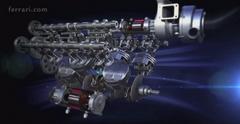 Ferrari has published a video explaining some of the tech and reason for it behind its 2014 Formula 1 race car, with some great illustrations demonstrating how it all will work together next season. The car may not have a name yet—the Italians will allow its fans to vote for the racer’s moniker online—but that hasn’t stopped the crew in Maranello from revealing some of the forthcoming car’s secrets.
Ferrari has published a video explaining some of the tech and reason for it behind its 2014 Formula 1 race car, with some great illustrations demonstrating how it all will work together next season. The car may not have a name yet—the Italians will allow its fans to vote for the racer’s moniker online—but that hasn’t stopped the crew in Maranello from revealing some of the forthcoming car’s secrets.At the heart of next year’s car is the 1.6-liter turbocharged V-6 known as 059/3. Limited to 15,000 revs, this engine will make roughly 600 horsepower and must be reliable enough to last for 2500 miles in order to meet the series’ new engine-allocation limit. Exhaust is routed upward by a single outlet, as will be the case for all of next year’s cars, to prevent the use of exhaust gasses assisting aero functions.
--------------------
· Feature: Hyping Hypercars—2014 Ferrari LaFerrari vs. 2014 McLaren P1, Lamborghini Veneno
· Feature: Kimi Räikkönen Is the Most Interesting Man in Formula 1
· First Drive: 2013 Ferrari F12berlinetta
--------------------
Unfortunately for those who were just coming to grips with the term “KERS,” it’s no longer relevant. In its place is each car’s Energy Recover System (ERS), which is made up of the Motor Generator Unit – Kinetic (MGU-K) and Motor Generator Unit – Heat (MGU-H). The Kinetic unit will act much like the KERS systems of old, hut the Heat unit will capture waste heat from the turbo and convert it to electricity. Whereas KERS allowed for an 80-hp bump for six seconds each laps, ERS will add 160 horses for up to 33 second each lap. Despite the increase in dependence on electric power, many teams are weary of the new fuel limit, which, at 100 kilograms, is about two thirds of what most cars were filled with throughout the 2013 season.
Check out the video below for more details on Ferrari’s 2014 campaign, and quotes on just how the Scuderia plans to address next year’s daunting changes. Reported by Car and Driver 1 day ago.